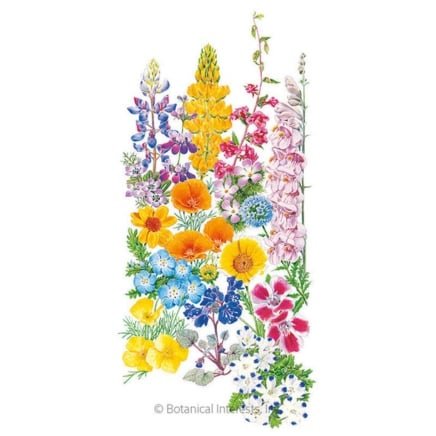Insects are the most abundant animals on earth. Many people seem to think that all bugs are annoying pests, although most bugs don’t have any particular interest in you or your plants. Beneficial insects provide essential services that benefit people and the garden. They are pollinators that help us grow our favorite foods, and they are predators that help control populations of true insect pests.
Perhaps the most familiar of the beneficial insects are bees and lady beetles. Bees are busy pollinators that help pollinate our favorite fruits, vegetables, and nut crops grown in gardens, farms, and orchards. Lady beetles are voracious predators of harmful insect pests. Beneficial insects also include lacewings, hoverflies, and parasitic wasps, among others, all of which help control populations of common garden pests.
All beneficial insects interact with plants in some way, using them as a food source, home, breeding site, or feeding site. The greater the variety of plants you grow, the higher diversity of beneficial insects you will attract. To maximize your garden’s appeal to beneficial insects, incorporate native plants into your landscape design and include species that bloom at different times throughout the year.
Let’s dig into more detail about 31 fabulous plants with plenty of garden appeal. These plants will attract a healthy population of beneficial insects to your yard and contribute to a thriving, healthy, and well-balanced ecosystem.
Angelica
If you’re hoping to attract beneficial insects and also make a bold statement, Angelica will do the trick. This herbaceous biennial plant produces leaves in its first year, then blooms and sets seed in its second year. It dies at the end of its second year but usually self-seeds or spreads vegetatively so you won’t lose your plants entirely.
Angelica’s large umbels of creamy yellowish-white flowers attract a myriad of pollinators. Ladybugs and lacewings are also attracted to these broad flower clusters. Dragonflies dart around in open sunny areas and pause to rest on taller leaves and stems such as those of Angelica. If providing a haven for beneficial insects isn’t enough, the leaves and stems of Angelica are also edible!
Basil

Basil is a flavorful annual that can be cooked, dried, or blended into a zesty pesto. It also makes a great insect-friendly addition to your herb garden or an ornamental for your annual flower beds. Basil is an ideal choice for your container garden or raised beds!
Most people are familiar with the tasty green or bronze leaves but basil also has attractive flowers. These compact flower spikes bloom throughout the summer and are a magnet for butterflies, bees, and other insect pollinators. Basil repels many common garden pests and makes an excellent companion plant for your flowers and vegetables.
Basket-of-Gold
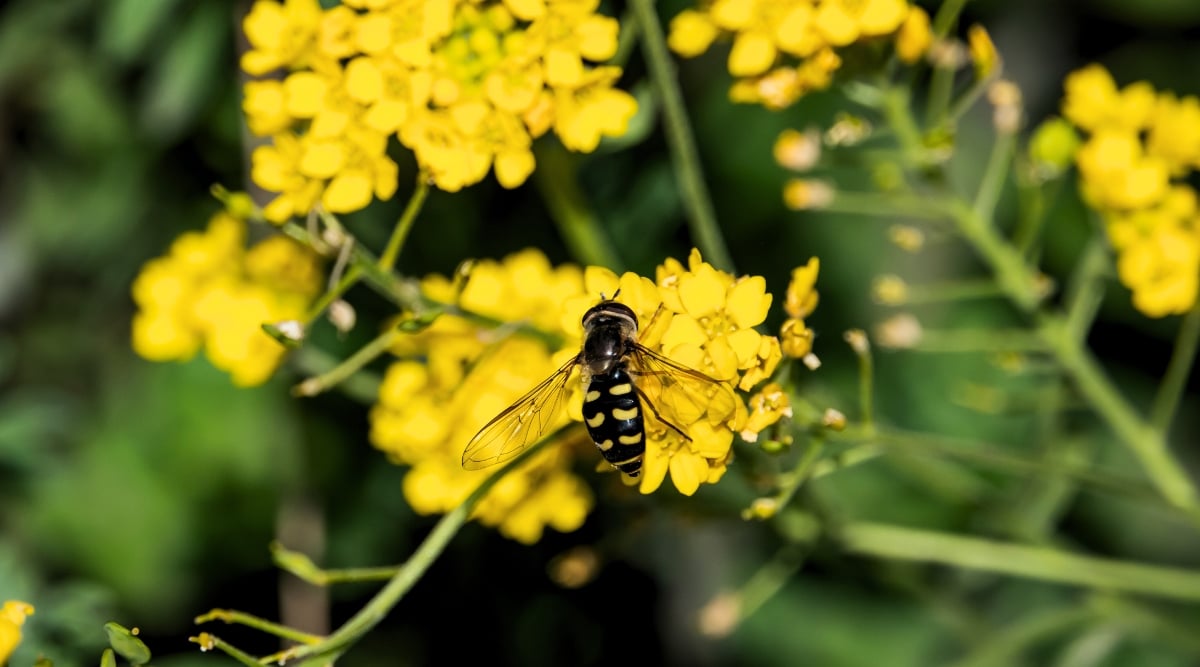
Here’s a fabulous plant for your rock garden or hillside garden. This vibrant, sun-loving perennial needs somewhat dry and very well-drained soil. It prefers a cooler climate and tends to be short-lived in hot climates with long summers. You can always grow it as a spring-blooming annual and replace it when it fades out with the summer heat.
Basket-of-gold is easy to start from seed and will self-seed in ideal conditions. This mounding plant blooms with a profusion of cheerful yellow flowers. These showy flowers attract pollinators and also provide feeding opportunities and habitat for predatory insects. The silvery green leaves are covered with a soft, downy fuzz and have a velvety feel.
Borage

Borage is underused in the garden. This fast-growing annual is easy to start from seed and easy to appreciate. Borage is low-maintenance, beautiful, edible, and attracts beneficial insects. Pollinators love the flowers and you’ll find other predatory insects using borage as a feeding station and resting spot.
Borage is right at home in your herb garden, annual flower garden, or interplanted among your summer vegetables. It blooms during the peak of summer with showy, pale blue, star-shaped flowers. Use young leaves and flowers in salads, or cook the leaves in a savory mixed-greens dish.
Buckwheat

Buckwheat is an interesting annual plant that is perhaps most commonly used as a cover crop. It’s also highly ornamental, edible, makes long-lasting cut flowers, and is very attractive to pollinators. Start new buckwheat plants from seed and you’ll have new seedlings sprouting quickly. For a similar plant with a beautiful pop of color, try ruby buckwheat.
Grow buckwheat in a sunny spot with well-drained soil. Use it as a cover crop to help enrich the soil and suppress weeds in your raised beds, garden rows, or in between spring and fall crops. While it’s growing and flowering, you’ll provide a valuable food source for honeybees. When it’s finished flowering, turn it into the soil as a green mulch.
Cilantro

This distinctive herb is an annual for your early spring herb patch. Direct sow seeds in late winter and they’ll sprout as soon as the soil warms. The leafy bunches can be harvested for fresh garnish but be sure to eat them while the weather is still cool because they’ll die back with the onset of full summer heat.
Cilantro blooms in late spring and early summer. It produces broad umbels of dainty white flowers which attract ladybugs, lacewings, and predatory flies. This is one of the earlier blooming pollinator plants you can grow to help prolong the pollinator season in your garden. After flowering, allow the seeds to mature on the plant, and it will self-seed for another crop the following year. Or collect them and use them as coriander in your kitchen.
Chocolate Daisy

The chocolate daisy is easy to start from seed. This native perennial comes from the dry grasslands of the southern United States and Mexico. In the home garden, grow it in sandy or gritty well-drained soil. This is an ideal option for your xeriscape or naturalized meadow garden.
Chocolate daisy, also called chocolate flower, blooms throughout the summer months. In ideal conditions, it can bloom continuously until the first frost. The cheerful yellow flowers have dark maroon-red centers. Pollinators love its flowers and birds will come to pick apart the seeds in autumn.
Crimson Clover

Crimson clover is an annual herb native to Europe. It’s often used as a cover crop, as cattle forage, or for erosion control. You don’t need an expansive farm to appreciate this plant, however. When you use it as a cover crop in your garden, till it back into the soil after blooming to help improve your soil fertility.
This fast-growing clover blooms just a few months after seeding. Its vibrant red flowers are a treat for bees, butterflies, and many other beneficial insects. The nectar-rich flowers are sure to be buzzing with insect activity while adding a burst of colorful pizzazz to your landscape. Use crimson clover in containers, raised beds, flower beds, and as a filler between crops in your veggie garden.
While crimson clover is beneficial in many ways, it can also spread and take over an area if you let it. It is currently listed as an invasive species in West Virginia.
Creeping Thyme
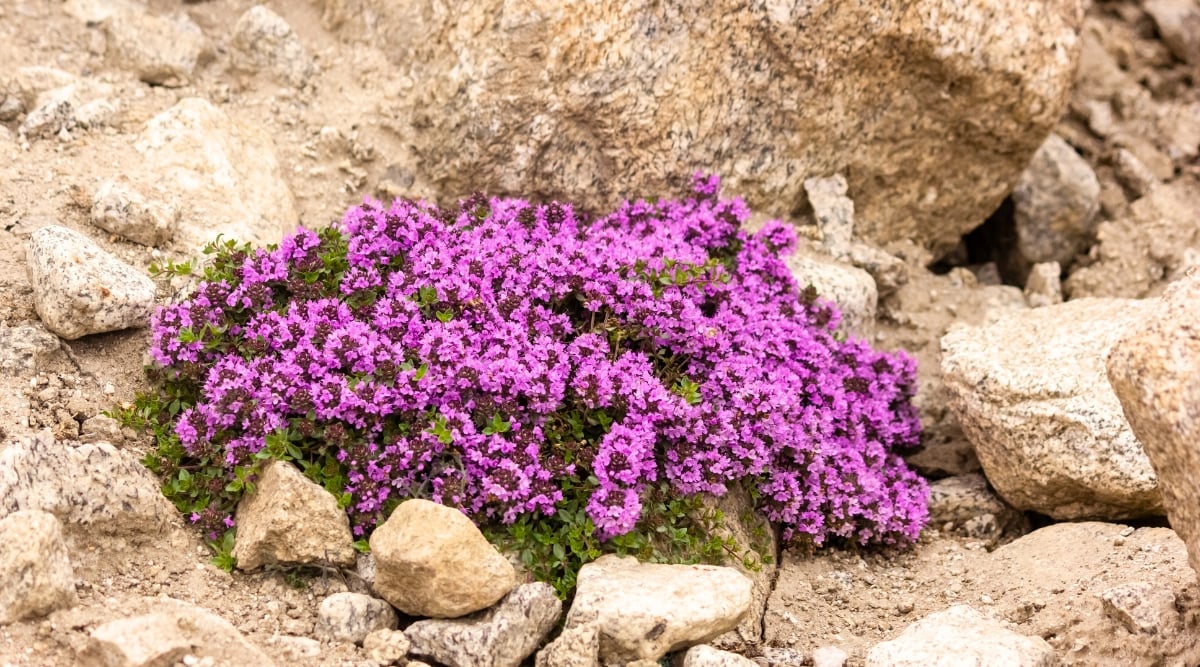
Creeping thyme may be small but it’s a big attraction for pollinators. Parasitic wasps and flies are also attracted to thyme and you may see these beneficial insects feeding on the flower nectar. Creeping thyme makes a great ground cover for small spaces and looks lovely in a raised bed or as part of your herb garden. Its abundant flowers bloom in the summer creating a low-growing carpet of purple blossoms.
Grow creeping thyme in full sun or very light shade. It requires well-drained soil and tolerates gritty, sandy, and shallow soil conditions. This variety of thyme is evergreen and its tiny fragrant leaves add year-round interest to your landscape.
Dill

Dill is an annual herb with a lot of garden appeal. Grow this highly aromatic plant in your butterfly garden, herb garden, or in a container. Put a few dill plants among your garden vegetables or perennial flowers.
Dill is an amazing pollinator plant. It blooms in early summer and attracts bees, butterflies, parasitic wasps, and hoverflies. It’s also a host plant for the black swallowtail butterfly caterpillar. Dill is amazingly easy to grow. Direct sow seeds in the spring, and then sit back, relax, and enjoy your dill plants. If you enjoy pickling and creating tasty seasonings, dill is a culinary essential.
Fennel

Fennel is a perennial herb with attractive frilly foliage. This plant has aromatic leaves, and edible seeds and stems. Grow it in your perennial garden, herb garden, or pollinator garden. Fennel is easily grown from seed and will readily self-seed in ideal growing conditions with moist, well-drained soil.
Fennel’s flowers are loose umbels of creamy yellow flowers. It blooms in the summer and is very attractive to bees, butterflies, ladybugs, lacewings, and other beneficial insects. It’s also a larval host plant for several species of swallowtail butterflies so don’t be surprised to see these boldly striped black, yellow, and green caterpillars feasting on your fennel plants during the summer months.
Goldenrod

There are over 100 species of goldenrod, many of which are North American natives. Whether you have a large space or small, dry soil or wet, you’re sure to find a goldenrod to suit your needs. These easy-to-grow perennials often spread vigorously by self-seeding and rhizomes.
If you’re looking for a sunny yellow wildflower to support beneficial insects, goldenrod is a good choice. Bees are especially fond of these late-season flowers. You’ll also find lady beetles, butterflies, blister beetles, and parasitic hoverflies using these plants as a nectar source. Goldenrods are best suited for a larger, naturalized plot such as a meadow garden unless you’re prepared to thin them annually to control any unwanted spread.
Joe Pye Weed

This is a tall, moisture-loving plant that attracts a wide assortment of beneficial insects. You will see butterflies, honeybees, and many other nectar-feeding insects. The broad masses of small pale purple flowers provide an excellent food source for all your favorite pollinators.
Joe Pye weed is hard to miss. This plant easily towers to seven feet tall in ideal conditions. It prefers consistently moist soil. Your plants will spread by rhizomes and self-seeding so give them plenty of space to roam. A naturalized streamside planting or moist meadow garden would be ideal!
Lantana

Lantana is a warmth-loving shrub that butterflies and hummingbirds adore. This easy-to-grow plant needs a sunny spot with moist, well-drained soil. Depending on the cultivar and your climate zone, your lantana may be evergreen or deciduous, and in cooler climates, you may need to prune this plant back to the ground after the first frost and wait for it to regrow the following spring.
Lantanas have an amazingly long blooming period. They typically start flowering by early summer and continue nonstop until the first fall frost. During this time, the colorful, rounded, flower clusters will be alive with beneficial insects of all varieties. Lantana leaves have a distinctive pungent odor that repels deer and rabbits.
There are several species of lantana native to North America. If you live in a region where Lantana camara is invasive, opt for a native species instead.
Lavender
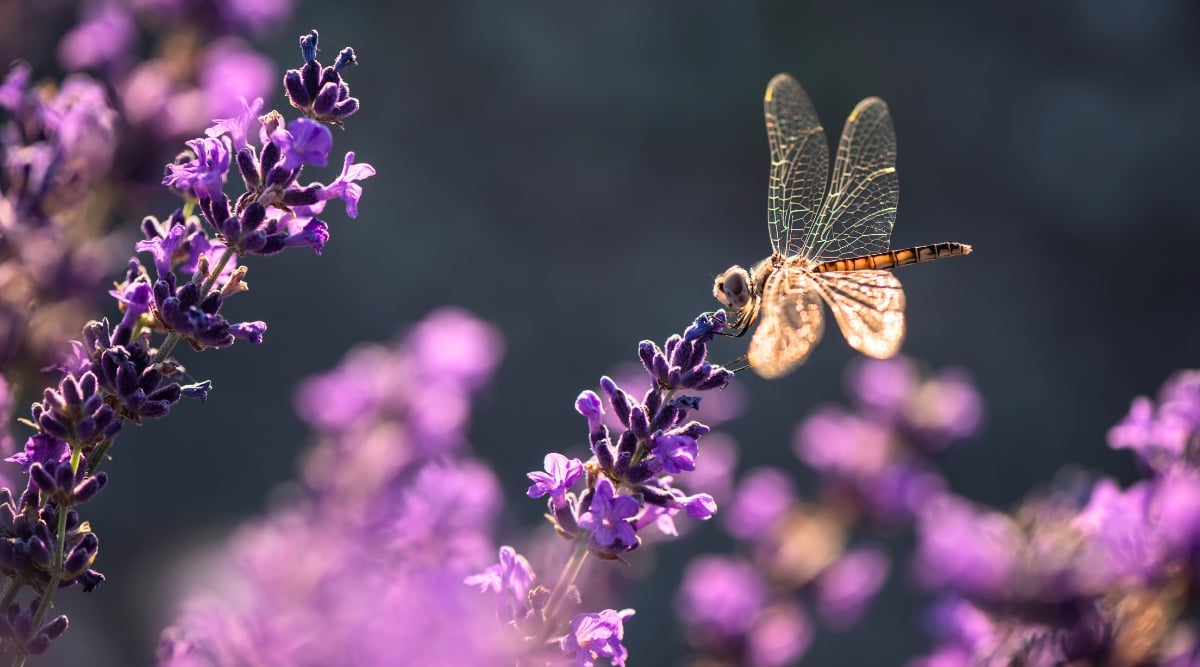
Lavender is a much-loved herb with beautiful flowers and sweetly fragrant foliage. This little shrub is a great plant for your herb garden or a sunny corner of your patio garden or rock garden. Lavender has good drought tolerance and is not bothered by browsing deer and rabbits.
Lavender is also a wonderful plant to support pollinators. The showy purple flowers bloom during the summer and provide a great nectar source. Bees and butterflies love lavender, and you’ll see lacewings and parasitic flies visiting the flowers as well. Dragonflies perch on the stem tips. You can also use lavender as a scent in homemade soaps and potpourri mixes, or use it as a flavoring in teas and cookies.
Marigold
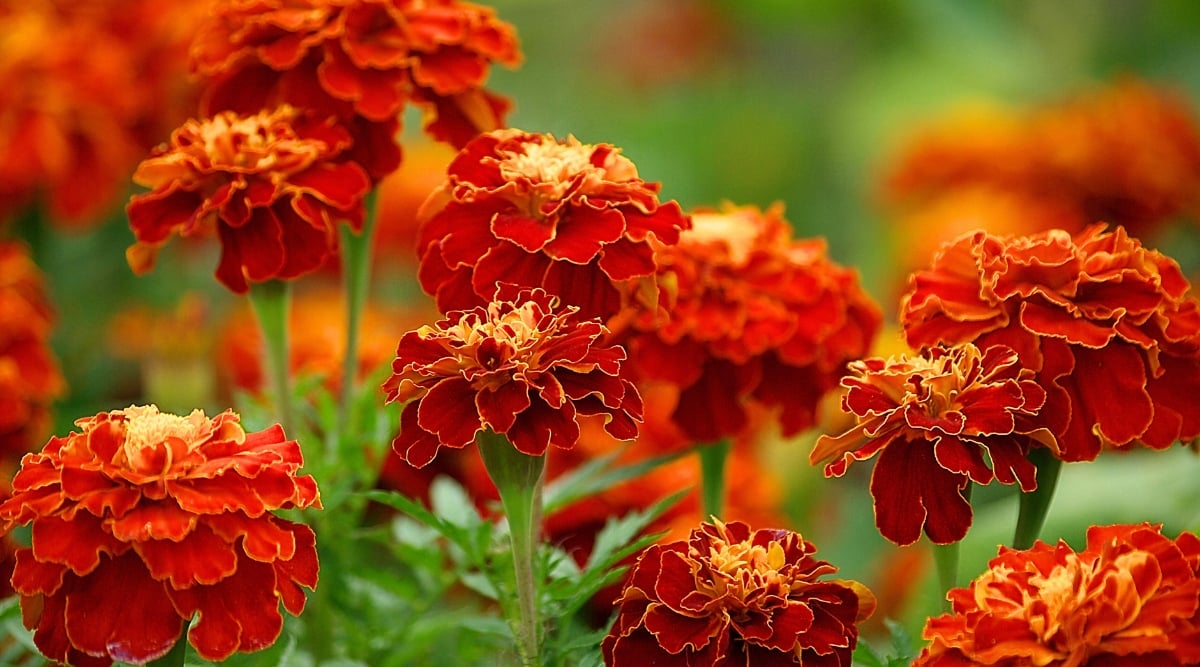
Marigolds are easy-to-grow annuals that are remarkably easy to incorporate into just about any garden setting. Marigolds prefer rich, moist, well-drained soil and are a great choice for raised beds, containers, or walkway borders. They are a preferred companion plant in the vegetable garden as well, helping to attract beneficial insects and repel insect pests.
These cheerful flowering plants enjoy a long season and bloom throughout the summer. Marigold flowers are most commonly varying shades of yellow and orange and some bi-color cultivars. Deadhead spent flowers to extend the blooming season and attract more pollinators!
Maximilian Sunflower
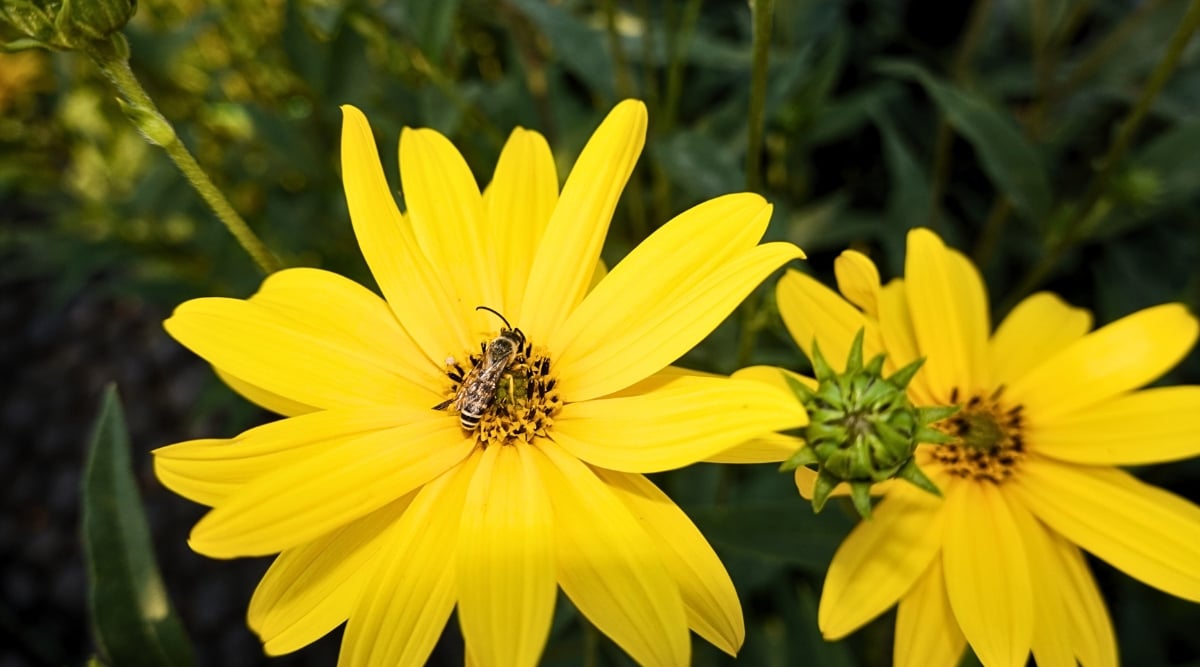
This native sunflower is a towering giant for your perennial wildflower garden. As it reaches toward the sun, it can grow up to 10 feet tall with many branching flowering stems. Unlike its giant relative with its huge, platter-sized flowers, Maximilian flowers are typically three to four inches across. These bright yellow blooms add plenty of color to your garden throughout the summer months.
Birds, butterflies, and many busy pollinators will all visit the flowers, seeking nectar, pollen, and seeds. They make excellent cut flowers for your summer wildflower bouquet. This is a great plant for a larger naturalized area such as a meadow garden. These hardy plants grow readily from seed and spread quickly to form dense colonies.
Mealycup Sage

Mealycup sage is an herbaceous wildflower native to the south-central United States and Mexico. This plant is a perennial in warmer zones and can be grown as an annual in cooler climates. All you need is a sunny spot with well-drained soil in your raised bed, container garden, pocket prairie, or woodland edge.
Mealycup sage blooms during the summer and into fall. Its dense purple flower spikes stand tall above the leafy stems. If you look closely at the individual flowers, you can see that parts are covered with a soft, downy fuzz. There are numerous other varieties of sage and salvia that are excellent plants for pollinators, so feel free to explore other options that would grow well in your garden. Pollinators and hummingbirds are highly attracted to these flowering sages.
Milkweed

If I had to recommend a single milkweed species, butterfly weed (Asclepias tuberosa) would be my top choice. There are numerous other milkweed species, however, that are amazing pollinator plants. Choose a species native to your region and you’ll have a showy, low-maintenance plant to enjoy and share with your local butterflies.
Milkweed plants bloom in late spring or early summer. Their showy, colorful, nectar-rich flowers attract not only butterflies but also native bees, ladybugs, and other beneficial insects and pollinators. After flowering, milkweeds produce interesting seed pods filled with silky white fluffy seeds. You can easily grow these plants from seed and, once established, they will spread in your garden to form attractive colonies.
Catmint

Whether you grow catnip or catmint, pollinators love these mint family flowers. Catmint plants are very easy to grow from seed or propagate from cuttings or division, and many species proliferate in the garden. Grow them in containers and overwinter them outside their hardiness range.
Any catmint plant has fragrant leaves and stems. These perennial plants bloom throughout the summer months and generally form dense clusters of tiny pale purple flowers. The flowers are extremely popular with butterflies, honeybees, ladybugs, lacewings, and other beneficial insects.
Nasturtium

Nasturtiums are popular annual flowers that are easy to grow from seed and quick to produce an abundance of flowers. Once they get started, the flowers last all summer, blooming strong until the first frost. These showy flowering plants are great for hanging baskets, containers, and raised beds.
If you’re looking for a pollinator plant, nasturtium is an excellent choice. Butterflies and bees are attracted to the flowers. These colorful flowers are trumpet-shaped and come in an assortment of shades of white, yellow, orange, pink, and burgundy. If their striking beauty and pollinator appeal aren’t enough, nasturtiums are also edible! The leaves and flowers have a unique peppery flavor to spice up salads. Add a few flowers to your next fruit salad for a tasty and decorative treat.
Purple Betony

Purple betony is a moisture-loving herbaceous perennial. Grow it in your cottage garden or perennial garden for a long season of beautiful purple flowers. Basal rosettes of heart-shaped leaves develop tall flowering stems by mid to late summer. Its showy spikes of tiny flowers have a prominent lower lip with an attractive purple and white pattern.
You can easily start purple betony by direct-sowing seeds. Established plants will readily self-seed for easy propagation. Give your betony plenty of space to spread, and you’ll soon have a great ground cover with spiky purple pollinator-friendly flowers. The long-standing flowers are a magnet for all your favorite pollinators and even hummingbirds!
Purple Coneflower

If I had to choose a favorite native wildflower, purple coneflower would be the one. This showy perennial is native to central and eastern North America, where it grows in prairies, meadows, and other grasslands. Well-established plants develop long taproots and become quite drought-tolerant.
If you have a bit of extra room in your perennial wildflower garden, you have space for a purple coneflower. The large and showy mauve-pink flowers bloom throughout the summer. Anytime the flowers are blooming, you can expect to see them heavily visited by butterflies, bees, and an assortment of other pollinators. After flowering, leave the seed heads for hungry seed-eating birds to pick apart. You can easily start these plants from seed and they’ll also reseed themselves in ideal conditions.
Rose Mallow

Rose mallow is a super-showy wildflower native to central and eastern North America. This shrub-like perennial can grow up to six feet tall and five feet wide. You’ll only be able to grow rose mallow if you have a consistently moist plot. Use it in your rain garden, pondside, or seasonally flooded plot so the roots won’t dry out.
This jumbo-sized perennial has giant, saucer-like flowers that span five to six inches across. The flower colors can include white, pink, and burgundy red. They bloom from mid-summer until early fall and put on quite a show. These plants are wildly popular with pollinators, attracting hummingbirds, butterflies, bees, and a myriad of other insects. Several species of butterflies also use rose mallow as a caterpillar host plant, making this an excellent all-around pollinator-friendly superstar.
Sulphur Cosmos

Cosmos flowers are a quick and colorful way to invite all sorts of beneficial insects to your garden. Butterflies and bees especially favor these flowers. Direct sow your cosmos seeds in the spring and your plants will be bursting with color by mid-summer. Allow your plants to set seed and collect some for the following year, although they often successfully reseed themselves without any extra help.
These beautiful flowering plants can grow quite tall. Plant them along a fence or surrounded by other taller flowers that can offer some support, or be prepared to stake taller plants if they start to lean to one side. Sulphur cosmos plants can be grown in containers or raised beds and also look great in your pocket prairie or surrounded by other nectar-rich flowers in your pollinator garden.
Sunflower
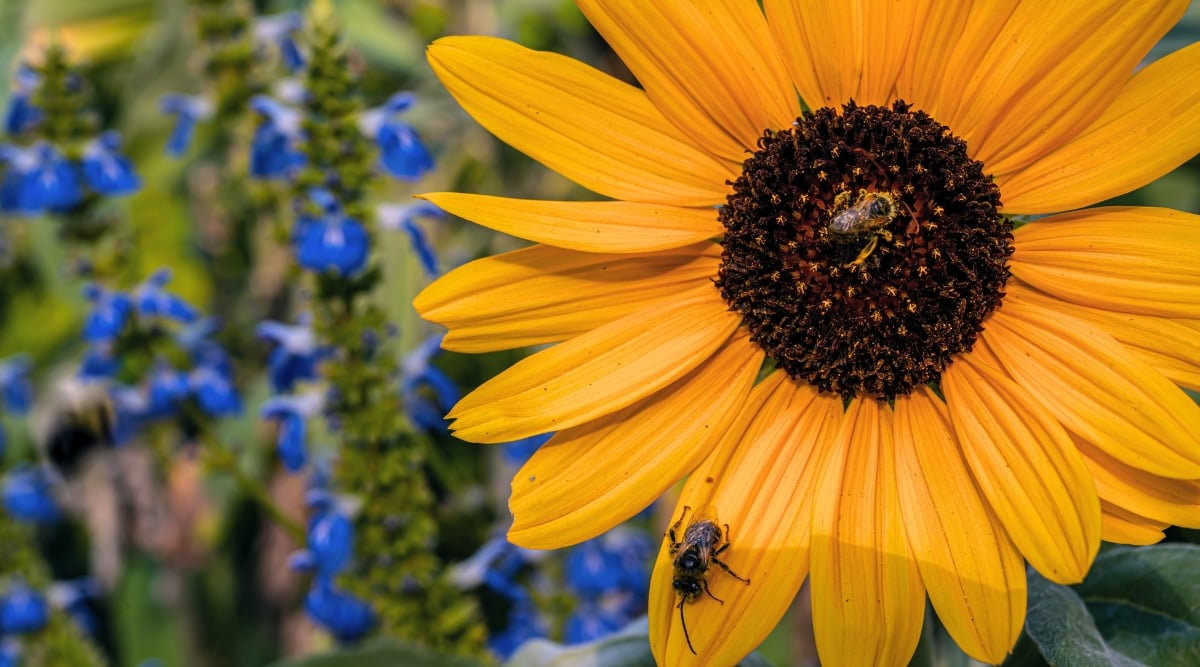
If you say “sunflower,” most people will first think of the giant sunflower with its towering stems and jumbo-sized flowers. This annual flowering plant can grow an incredible amount in a single growing season; a seed planted in the spring can reach a whopping ten feet tall or taller by mid-summer. Not all flowers in this family are giants, however, and they aren’t all yellow, either! Check out the amazing variety of sunflowers available and choose your favorite.
These plants need plenty of space to reach their maximum potential. Grow several together for a truly outstanding display. They’ll provide an abundance of seasonal curb appeal and prime feeding opportunities for any visiting pollinators. Butterflies, bees, lady beetles, and lacewings will feed on the nectar in the summer while birds will happily pick apart the energy-rich seeds in the autumn.
Sweet Alyssum

This low-growing flowering annual is a popular garden plant that’s easy to start from seed and enjoy fully-grown blooming beauties by mid-summer. Grow sweet alyssum with well-drained soil. These plants are ideal for growing beside walkways, along borders, draped over a stone wall, or nestled between larger stones in your rock garden.
Sweet alyssum cultivars come in a colorful assortment. The flower clusters are sweetly fragrant and very attractive to pollinators and predatory insects. Prune back spent flowers to encourage further blooming but allow some to form seeds to sprout the following spring. This plant makes a lovely ground cover and is a great option for containers.
White Lace Flower

The white lace flower, also called orlaya, is a compact plant that compliments its neighbors well. These annuals aren’t too big or too small; they’re an ideal medium size with elegant, finely cut foliage to add an interesting texture to your garden plot. The showy, white-flowering umbels bloom continually from early summer until the first frost.
White lace flowers are easy to grow from seed and low maintenance. Use them in your pollinator garden, container garden, or cutting garden. Use them among other annuals or grow them to fill in gaps along borders and edges in your perennial flower garden.
Wild Bergamot

Wild bergamot is a member of the mint family and native to central and eastern North America. This fragrantly scented plant grows well in containers and raised beds, or use it in your perennial wildflower garden to help attract pollinators. Butterflies, bees, and hoverflies are attracted to these pale purple mint flowers, as well as hummingbirds! Deer don’t like to eat mint, but people may enjoy using the leaves in teas or potpourri blends.
Wild bergamot needs well-drained soil with regular moisture. Like most mints, this vigorous plant will spread by self-seeding and underground rhizomes. Easily grown from seed, you’ll just need a few plants to get started and then you propagate your own if you need more, or allow them to spread to form a colony.
Yarrow

Yarrow is a must for anyone who wants to attract pollinators with minimal effort. These easy-to-grow perennials appeal to butterflies, bees, lacewings, ladybugs, hoverflies, and parasitic wasps. Yarrow is easy to start from seed, easy to grow, and easy to transplant. Once you get a patch started, it will take care of itself, although you may need to thin it occasionally.
Yarrow is a low-growing plant that makes an excellent ground cover. The fern-like leaves and broad flower umbels look great along borders or incorporated into a flower garden. Yarrow grows well in containers and raised beds alongside other colorful and pollinator-friendly flowers.
Zinnia
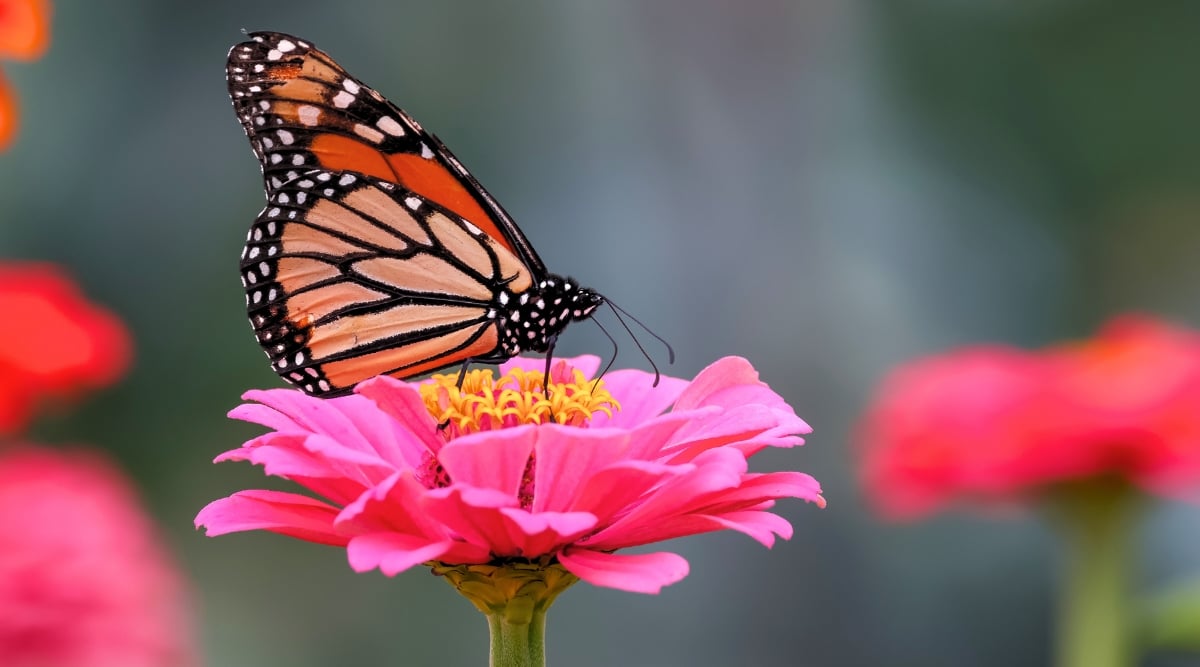
Each year, I always seem to have a few gaps in my summer flower garden. Each year, I fill these gaps with a zinnia. Whenever I look at those zinnia flowers blooming throughout the summer, they are alive with pollinator activity. Hummingbirds also love these flowers. These colorful annuals are super easy to start from seed and add a splash of brilliant color wherever they grow.
Choose a location with moist, well-drained soil for your zinnias. There are many different varieties to choose from, including compact plants with an abundance of one-inch wide flowers and waist-high plants with spectacular four-inch flowers. Choose the variety that best fits your space and feel free to create a zinnia patch in your annual garden. The more flowers you have, the more pollinators you’ll feed.
Frequently Asked Questions
Absolutely! You don’t need a large natural area to attract pollinators and other beneficial insects. You don’t even need a garden plot. You can start a container garden on your patio or a raised bed in a sunny spot near your house. As long as you have a bit of light and enough space to grow a flowering plant, you can attract pollinators.
Of course, the more space you have, the more flowers you can plant, and the more flowers you have, the more species of beneficial insects you can help support. If you have a grassy lawn, try converting some of your lawn into a flower bed and you’ll be amazed how quickly the butterflies and birds find it and make themselves right at home!
Attracting beneficial insects takes a little more than just planting flowers. Think about attracting beneficial insects and then providing a safe haven for them.
- Avoid pesticides. Pesticides will kill your good bugs as well as your bad bugs. If you can provide a safe habitat for ladybugs and lacewings, they’ll help you by eating aphids and other pesky insect pests.
- Grow a four-season garden. Use flowering plants that bloom during each season providing nectar and foraging opportunities throughout the entire growing season. Broadleaf evergreens, shrubs, and trees offer shelter throughout the winter for both adults and larval insects.
- Leave your leaves. Dead leaves and standing dead vegetation provide shelter for overwintering insects. Wait until spring to do some of your garden cleanup.
- Provide water. If you can, offer small puddles, a bird bath, or some damp sand. You’ll be amazed how many butterflies sip water from these sources.
- Grow cover crops. When you have some bare soil between your garden crops, consider growing clover or buckwheat cover crops. Wait for them to flower and attract extra beneficial insects to your veggie garden, then turn the crops into the soil for extra nourishment.
- Lady beetles. These familiar beetles are typically red with black spots. Their larvae look like funny miniature black and orange alligators crawling around on plant leaves. Both the adults and larvae consume massive numbers of aphids.
- Green lacewings. These pretty little bugs have elongated green or brownish bodies and relatively large, delicate lacy green wings. They devour aphids, mites, other small pests, and even the eggs of various insect pests.
- Hoverflies. Also known as syrphid flies, these predatory flies look more like miniature bees but they don’t sting. They hover in place, searching for their next meal of aphids and mealybugs.
- Parasitic wasps. These fascinating insects look like an elongated cross between a fly and a wasp but they don’t sting. They prey on caterpillars, such as the common tomato hornworm caterpillar, by laying their eggs on it. When the eggs hatch, the larval wasps then eat the caterpillar.
- Dragonflies. Dragonflies are large flying insects that dart through the air with amazing speed and agility. These beautiful insects often have bright, sometimes iridescent, colors on their bodies that seem to shimmer in the light. Dragonflies consume all sorts of flying insects, especially mosquitoes and flies.
- Bees. Everyone is familiar with the honeybee. These common pollinators are responsible for making the sweet honey that we eat. These and other bee species are also essential pollinators for many of our favorite fruits and vegetables.
- Butterflies. Probably everyone enjoys seeing butterflies fluttering around from flower to flower. These colorful insects glide gracefully on their delicate, broad wings and act as pollinators as they go. You can attract butterflies to your landscape by providing a variety of nectar-rich flowers and also host plants for their caterpillars to eat.




